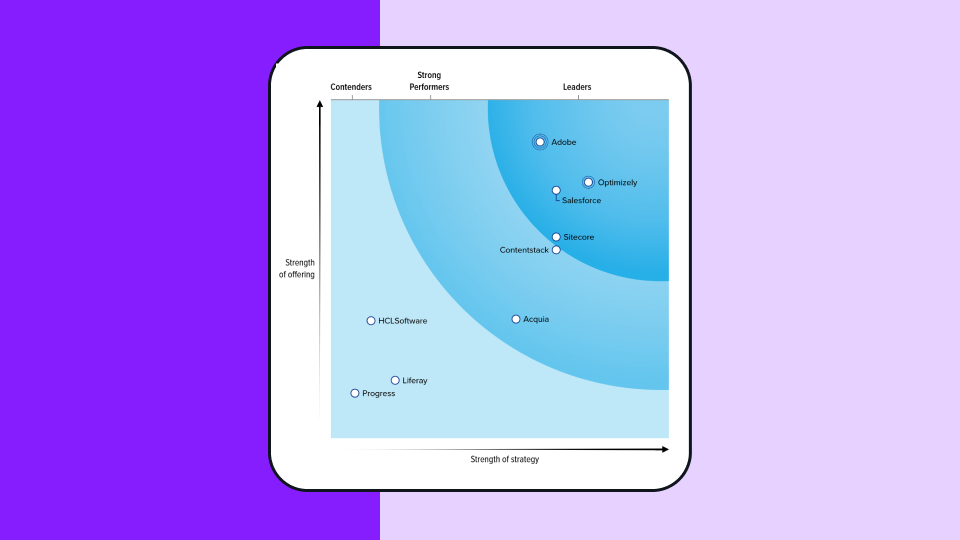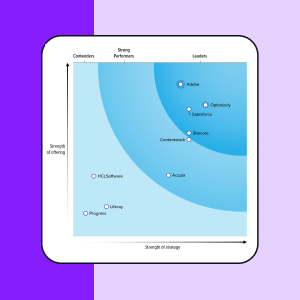Hyper-Personalisierung
Was ist Hyper-Personalisierung?
Hyper-Personalisierung nutzt künstliche Intelligenz (KI) und maschinelles Lernen (ML), um über die Segmentierung hinauszugehen und Ihnen die Möglichkeit zu geben, ein individuelles, einzigartiges Erlebnis zu schaffen.
Durch den Einsatz von Big Data, Analysen, individuellen Customer Journey Maps und personalisierten Inhalten tragen hyper-personalisierte Erlebnisse dazu bei, Kunden zu gewinnen, Gewinne zu steigern und Kosten zu senken. Laufende Bemühungen um eine bessere Segmentierung der Kunden sind nützlich, aber KI ist effektiver, wenn es darum geht, schnell auf Änderungen im Verhalten eines Besuchers zu reagieren. Mit Hyper-Personalisierung können Vermarkter Erlebnisse proaktiv anpassen, um einzigartige Touchpoints zu schaffen, die auf den einzelnen Besucher personalisiert sind.
Hyper-Personalisierung zielt darauf ab, dauerhafte Beziehungen aufzubauen, aussagekräftige Reaktionen hervorzurufen und einzigartige Erlebnisse zu liefern, um die Conversion Rate zu erhöhen und den Customer Lifetime Value zu steigern.
Wie funktioniert Hyper-Personalisierung?
Echtzeitdaten werden mit KI-Verarbeitung kombiniert, um zu steuern, wie Sie Inhalte bereitstellen, nächste Schritte vorschlagen, auf Ereignisse reagieren und so jeden Touchpoint in Ihrer Customer Journey-Map auf der Grundlage von Kundendaten steuern. Sie können damit zwar nicht Ihre Strategien entwerfen oder Ihre multivariaten Tests ersetzen, aber Sie können die Daten nutzen, um zu steuern, wie Sie den Nutzern Erlebnisse bieten.
Bei der Hyper-Personalisierung müssen Sie verschiedene Verhaltensweisen modellieren und Algorithmen mit Echtzeitdaten verwenden, um zu entscheiden, wann der optimale Zeitpunkt für die Übermittlung einer Mitteilung, eines Hinweises oder eines Angebots ist. Jeder Berührungspunkt in Ihrer Journey Map kann von der Hyper-Personalisierung profitieren, indem Sie direkt mit den Nutzern in Kontakt treten und ihre Bedürfnisse genau antizipieren.
Vorteile der Hyper-Personalisierung
Traditionelle Personalisierungstechniken halfen Unternehmen dabei, mit Kunden in Kontakt zu treten und gezielte Inhalte und Erlebnisse auf der Grundlage historischer Analysen zu erstellen. Die Hyper-Personalisierung erfordert nach wie vor CX-Designer, multivariate Tests und Experimentieren, um Journeys zu erstellen, nutzt aber personalisierte Lieferalgorithmen, um das gesamte Erlebnis zu optimieren.
Unternehmen, die Hyper-Personalisierung einsetzen, profitieren davon:
- Weniger Hindernisse in der Sales Journey, die das Erlebnis erschweren und Besucher daran hindern, Kunden zu werden
- Sie verhindern, dass überforderte Kunden ihren Einkaufswagen verlassen, indem sie spezifische Algorithmen verwenden, die die Auswahl auf der Grundlage des aktuellen und früheren Verhaltens eines Besuchers einschränken (anstatt sich allein auf Segmentierung und Automatisierung zu verlassen).
- Gewinnung und Bindung neuer Kunden mit einzigartigen Botschaften, Mitteilungen, Angeboten und Inhalten, die den Umsatz steigern
- Mit den sich ständig weiterentwickelnden Kundenerwartungen Schritt halten und sicherstellen, dass die Inhalte, die Customer Journey und das Gesamterlebnis den neuesten Trends entsprechen
Erfolgsmethoden der Hyper-Personalisierung
Hyper-Personalisierung erfordert von Unternehmen eine kontinuierliche Optimierung der Journey auf der Grundlage der Datenerfassung in Echtzeit. Das Experimentieren mit verschiedenen Inhalten und Erlebnissen ermöglicht es Ihnen, das Framework zu verbessern und optimierte Algorithmen zu erstellen, während die Technik hinter dem Prozess es Ihnen ermöglicht, nahezu jedes Element in Ihrem Lieferprozess zu automatisieren.
Um den besten ROI aus der Hyper-Personalisierung zu erzielen, sollten Sie:
- bei jedem Besuch die richtigen Daten sammeln und so viele einzigartige Informationen über Besucher wie möglich aufzeichnen
- Stellen Sie auf der Grundlage früherer Interaktionen maßgeschneiderte Angebote bereit und nutzen Sie KI-Algorithmen, um die Customer Journey bei jedem weiteren Besuch weiter zu optimieren.
- Stellen Sie personalisierte Inhalte und Nachrichten auf all Ihren Websites, sozialen Medien, Apps und anderen neuen Plattformen für die Personalisierung bereit.
- Testen Sie verschiedene hyper-personalisierte Erlebnisse und nutzen Sie diese Informationen, um das Design Ihrer Inhalte und die Bereitstellungsmethoden zu perfektionieren und - was noch wichtiger ist - um den richtigen Zeitpunkt für die Bereitstellung der Inhalte zu bestimmen.
Sie müssen alle relevanten Daten, die Sie sammeln, nutzen, um Ihr KI- und ML-Modell mit Ihren Kunden weiterzuentwickeln und zu verstehen, wo Reibungspunkte entstanden sind, damit Sie diese im Laufe der Zeit beseitigen können.
Prozess der Hyper-Personalisierung
Die Schaffung eines hyper-personalisierten Erlebnisses beginnt mit der Nutzung neuer und vorhandener Daten, um detaillierte Profile für jeden Besucher zu erstellen. Ein DXP ermöglicht Ihnen einen schnellen Einstieg, indem es Ihnen hilft, Inhalte auf der Grundlage Ihrer bestehenden Berührungspunkte zu personalisieren, Ihre Segmentierung für einzigartige Profile zu optimieren und Ihre Bereitstellung über alle Kanäle zu rationalisieren.
Dies sind die wichtigsten Elemente einer Hyper-Personalisierung:
-
Daten
Beginnen Sie mit dem Sammeln und Optimieren von Verbraucherdaten, indem Sie die Besonderheiten jeder einzelnen Reise ermitteln. Anschließend können Sie eine Personalisierungsstrategie entwickeln, um diese Informationen in Ihrer hyper-personalisierten Customer Journey optimal zu nutzen. -
Inhalt
Als Nächstes erstellen Sie die Inhalte für jede einzelne Reise, von denen Sie glauben, dass sie das Gesamterlebnis beeinflussen können. Entscheiden Sie sich für die Art der Zustellung (E-Mail, Popup-Nachrichten oder spezielle Angebote), die Besucher wahrscheinlich in wiederkehrende Kunden verwandeln wird. -
Liefern Sie
Stellen Sie sicher, dass Sie über alle digitalen Berührungspunkte hinweg konsistente, individuelle Erlebnisse zur richtigen Zeit, optimiert für das jeweilige Gerät und entsprechend den persönlichen Vorlieben des Kunden liefern. Ihre Analysen helfen Ihnen bei der Optimierung Ihres Content Management Systems (CMS) und Ihrer Auslieferungspläne. -
Vereinheitlichen Sie
Führen Sie alle anderen Elemente zusammen, indem Sie einen DXP verwenden, der die Auslieferungszeitpläne nach eindeutigen Profilen automatisiert und es Ihnen ermöglicht, weiterhin mit Inhalten zu experimentieren und die Algorithmen einzurichten, um alle Erlebnisse weiter zu optimieren.
Anwendungsfälle der Hyper-Personalisierung
Hyper-Personalisierung ist nicht völlig neu - viele Unternehmen haben bereits bewiesen, dass es sich lohnt, diese Strategie bei der Gestaltung ihrer Digital Journeys zu verfolgen. Neu ist jedoch, dass die Systeme, die diese neuen Funktionen bieten, nicht mehr nur den größten E-Commerce- und SaaS-Unternehmen zur Verfügung stehen.
Einige der Unternehmen, die von der Hyper-Personalisierung profitiert haben, sind:
Airbnb
Airbnb hat damit begonnen, Standortdienste zu nutzen, um eine Vielzahl von Formularen automatisch auszufüllen, je nachdem, für welchen Service sich der Besucher auf der Site anmelden wollte. Sobald der Besucher sich angemeldet hat, ist jede Reise einzigartig für die Person, und es wird ein vollständiger Verlauf aller Interaktionen auf der Site gespeichert.
Reebok
Selbst wenn jemand keinen Kauf im Reebok Store abschließt, verfolgt die Site alle Ereignisse des Besuchers und schickt Ihnen, wenn Sie sich für den Erhalt von Mitteilungen angemeldet haben, eine personalisierte E-Mail, die Ihnen die besten Produkte entsprechend Ihrem Surfverhalten empfiehlt. Reebok verfolgt den Besuch jedes Nutzers, verwendet Algorithmen, um die entsprechenden Produkte zu identifizieren, und erstellt eine automatische Produktliste mit einer eindeutigen Nachricht unter Verwendung der Hyper-Personalisierung.
Amazon
Auch hier gehört Amazon zu den Early Adopters, die ihr gesamtes Ökosystem auf Hyper-Personalisierung aufgebaut haben. Die Nutzer erhalten einzigartige Homepages, hochpräzise Produktempfehlungen, die Möglichkeit, ihre Bestellungen durch zusätzliche Artikel zu erhöhen, und ein nahtloses Checkout-Erlebnis. Von Anfang an war Amazon bestrebt, die Reibungspunkte entsprechend den Routinen und Vorlieben der Kunden zu reduzieren.
Sinnvolle Verbindungen durch Personalisierung schaffen
Die meisten CMOs müssen ihre Gewinne steigern, neue Produkte entwickeln und das Erlebnis kontinuierlich verbessern, indem sie datengesteuerte Entscheidungen treffen. Hyper-Personalisierte Inhalte helfen dabei, diese Ziele zu erreichen, wenn sie genau zum richtigen Zeitpunkt bereitgestellt werden und sich mit der einzigartigen Reise des Nutzers entwickeln. Als weltweit größtes Unternehmen im Bereich des Experimentierens kennen wir uns mit der Nutzung von Daten zur Entscheidungsfindung und der Bereitstellung von Millionen von Seitenvariationen für Besucher bestens aus.
Optimizely Personalization ermöglicht es Ihnen, all diese Erkenntnisse zu nutzen und sie für ein hyper-personalisiertes Publikum auf allen Kanälen anzuwenden. Machen Sie Ihre Website-Inhalte noch heute wirklich personalisiert.

